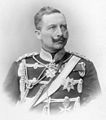Triple year
The year 1888 went down in German history as the three emperor year .
On Kaiser Wilhelm I , who in March 9, Berlin died, followed by his on laryngeal cancer diseased son Friedrich Wilhelm as Kaiser Friedrich III. who died in Potsdam on June 15 after a reign of 99 days . He was followed on the same day by his eldest son Friedrich Wilhelm, who ascended the throne as Kaiser Wilhelm II as German Emperor and King of Prussia . Within just four months, the German Empire was ruled by three rulers from successive generations.
Wilhelm I.
1871–1888Friedrich III.
1888Wilhelm II.
1888–1918
numismatics
In the three emperors year, only one coin was minted, each with an image of one of the three emperors who ruled in 1888 . The 20-mark gold coin was made in the Berlin Mint (A) with the following total minting numbers:
- Wilhelm I. ( Jaeger 246): 533,854 copies,
- Friedrich III. (Jaeger 248): 5,363,501 copies and
- Wilhelm II. (Jaeger 250): 755,512 copies.
Comprised of these three coins set is sought after by collectors and has the degree of preservation uncirculated a value of about 1,500 euros. In relevant mints it is offered for an average of around 2,300 euros.
Other coin values were only issued for two of the three emperors in 1888: the 2-mark and 5-mark silver coin for Friedrich III. and Wilhelm II., the 10-mark gold coin for Wilhelm I and Friedrich III.
Trivia
- In connection with the Year of Three Emperors emerged in the vernacular of the saying : "William I was the aged Emperor Frederick III. the wise (or "quiet") Kaiser and Wilhelm II. the travel emperor. " . This indicated the high age of Wilhelm I at almost 91 years of age and the silence of Frederick III caused by throat cancer shortly before his accession to the throne . Referenced.
- The following saying can help to remember the three emperors year: "One and three times eight: three emperors in power".
- In ancient times , there were 69 n. Chr. A Year of the Four Emperors , 193 n. Chr. A Second Year of the Four Emperors and 238 n. Chr. A Year of the Six Emperors . In the former, four potential successors fought for rule in the Roman Empire after Nero's death . Here sat Vespasian by and founded the dynasty of the Flavian emperors .
- Because of the shape of the last three digits, the year 1888 was humorously called the three-pretzel year.
See also
Web links
Individual evidence
- ^ Gerhard Schön, Günter Schön: Small German coin catalog: from 1871 to today . Battenberg, 2016, ISBN 978-3-86646-125-3 ( limited preview in Google Book Search).


